Here’s the third of three posts from Xubin Zeng (Univ. of Arizona) and Peter Lamb (Univ. of Oklahoma), who congratulated Robert Dickinson, Brian Hoskins, and Qingcun Zeng for joining them in the ranks of AMS Fellows by asking a few questions by email. This is the interview with Dr. Zeng:
How did you decide to choose atmospheric science or a related field as your profession?
I was born in a peasant family, grew up in the countryside, and personally experienced the strong impact of climate and weather on the agriculture and human life. When I was a student in the Physics Department of Peking University in the 1950s, several meteorological disasters occurred in China, and there was an urgency to develop meteorological service and research. The university and professors suggested us, at least some of us, to study “atmospheric physics”. Thus I chose atmospheric sciences for the future profession. Meantime, the first success of numerical weather prediction was very exciting; therefore I decided to choose numerical weather prediction as my first subject for research.
Who influenced you most in your professional life?
I am very lucky having very kind parents, excellent teachers and supervisors, and many good friends, as they all strongly influence my life. I can’t express how grateful I am to them.
By precept and example, my parents instilled in me the values of fundamental morals and hard work. My teachers, especially Profs. Y.-P. Hsieh, T.-C. Yeh, and E. A. Kibel’, taught me both the research subjects and methodology. Professors Yeh and Hsieh were important members of the Chicago School, while Prof. Kibel’ was a founder of the Petersburg-Moscow School. Their ideas as well as Chinese philosophy converge in my mind, creating new ideas. Professor J. Smagorinsky showed me how to run a research center when I was a visiting senior scientist at the Geophysical Fluid Dynamics Laboratory (GFDL). Taking this as an example, I established a center of numerical modeling in our institute (IAP/CAS).
Which accomplishments are you most proud of in your professional life?
From a developing country (China), I have been thinking more about how China can learn from and catch up with developed countries in atmospheric sciences. My overall contributions to atmospheric sciences are small. Two pieces are worth mentioning here.
Since 1960s, I have paid special attention to the fundamental physio-mathematical problems, such as the well-posedness of governing equations with proper initial and boundary conditions, the internal consistence of the models written in both the differential and numerical forms, as well as some general features and laws in the rotating fluid dynamics. Some results have been applied to the designs of numerical weather prediction and earth system models in China. These work has also attracted some mathematical scientists to this field.
I have also been gradually involved in the new field of the global change and sustainable development since mid-1980s. I proposed a theoretical framework, the “natural cybernetics”, to try to unify the prediction and regulation of regional atmosphere-environment as a problem of system engineering. This would combine massive observations and practical experiments with mathematical models and numerical modeling. I am looking forward to the future progress in this area by the young generations.
What are your major pieces of advice to young scientists in our field?
Carefully observe and deeply think.
What are your perspectives for future direction of our field?
We have seen the close confluence of atmospheric Sciences and other branches of Earth Sciences with the goals to deeply understand and properly utilize the Earth environmental systems. The weather and climate predictions remain an important subject in the future. In addition, the studies on problems related to planning human activities in order to properly utilize and correctly regulate the natural atmospheric-environmental systems have just started, and should be strengthened.
AMS2014
New Honorary Members of the AMS: Brian Hoskins
Here’s the second of three posts from Xubin Zeng (Univ. of Arizona) and Peter Lamb (Univ. of Oklahoma), who congratulated Robert Dickinson, Brian Hoskins, and Qingcun Zeng for joining them in the ranks of AMS Fellows by asking a few questions by email. This is the interview with Dr. Hoskins:
How did you decide to choose atmospheric science or a related field as your profession?
I never really chose it! After I had started using mathematics to study aspects of dynamical phenomena in the atmosphere it just became clearer and clearer that this combination of a superb system to understand and the practical importance of the subject became more and more what I wanted to continue with.
Who influenced you most in your professional life?
There have been so many it would be invidious to choose one. However, it was Francis Bretherton who started me of on the atmospheric science direction at Cambridge. He gave me the first course I had on applying mathematics to the ocean and atmosphere, had a PhD studentship available on atmospheric fronts, accepted me for it and guided me through the next 3 years.
Which accomplishments are you most proud of in your professional life?
Some of my research highlights; helping the Department of Meteorology at Reading and more recently the Grantham Institute at Imperial develop; my role in the international arena, e.g. WCRP and IAMAS; playing a leading role in the UK in its plans for carbon reduction targets.
What are your major pieces of advice to young scientists in our field?
Enjoy your research. Take a wide interest in the subject and lay the foundation so that you can take the opportunity when it arises to put different strands together in a way no one else has.
What are your perspectives for the future direction of our field?
In my research life atmospheric dynamics has gone from being the tops to being quite out of favour. To make major advances in observing and modeling weather and climate we must develop new frameworks of understanding that focus on phenomena, and the dynamics interacting with the range of physical processes in them.
New Honorary Members of the AMS: Robert Dickinson
Xubin Zeng (Univ. of Arizona) and Peter Lamb (Univ. of Oklahoma) congratulated Robert Dickinson, Brian Hoskins, and Qingcun Zeng for joining them in the ranks of AMS Fellows by asking a few questions by email. Here is the interview with Dr. Dickinson:
How did you decide to choose atmospheric science or a related field as your profession?
When I was a teenager my interests were broad so my interest in science only developed through science courses I took at Exeter and Harvard, and I ended up my undergraduate career with a double major (chemistry and physics). I went into a meteorology program at MIT as a graduate student because I wanted a career more tied to nature. Unfortunately, I stumbled into doing theoretical studies that gave me little opportunity for the field work I had imagined. However, I had no end of opportunities to work on questions of great interest to me which kept me motivated to this day to continue in atmospheric science related research.
Who influenced you most in your professional life?
This is a difficult question as I am grateful to so many people who influenced my professional career. It would be easier to name “the hundred most”. However, in narrowing it down to one, I have to pick my thesis advisor Victor Starr, since his broad interests and approach to scientific research, as a generally enjoyable and relaxing activity, using theoretical reasoning and observations to reveal and interpret basic physical processes, was conveyed to me at a very impressionable age and so had a strong impact on all my future work.
Which accomplishments are you most proud of in your professional life?
I spent much of my career at NCAR, doing many things, and in the early seventies worked with Steve Schneider and others to develop an NCAR climate research initiative, and evolve many of the concepts used today involving climate forcing and feedbacks. That led me a few years later to my learning how to use General Circulation models and to a recognition that their land part was their weakest component, given its overall importance in the system. My consequent efforts to make a better such component model forced me to learn all I could learn about vegetation and leaves. To do this forced me to borrow concepts from many people and learn the need for extensive interdisciplinary activity to be able to make meaningful progress on such a model.
What are your major pieces of advice to young scientists in our field?
Making successful progress in research requires a lot of long hours and hard work so it must be fun for you to put in the effort needed.
Your work will have a much bigger impact if communicated and recognized by many people. You need to write effective papers and to give good oral presentations to have such impact and recognition.
What are your perspectives for future direction of our field?
I think young scientists are better able to answer this than I, so I only suggest a framework: the most important future directions will involve some combination of advancing basic science, responding to societal needs, and employing new technologies. I think at least two of these characteristics are needed for a future direction to be important.
Extreme Communicators–from Parked Cars to Perfect Calligraphy
Some AMS Annual Meeting attendees may have been surprised when Andy Revkin pulled out his guitar at the Presidential Forum on Monday. Maybe they didn’t know that Revkin is an accomplished songwriter and performer who has already recorded an album. But they certainly appreciated that singing about the perils of flash flooding in Colorado is a way for Revkin to show by example what he means when he writes:
. . .the gap between information and impact can also be substantially reduced (without a large financial cost) simply if more scientists and scholars, and their institutions, think creatively about ways to expand their communication circles and pathways.
Even for those of us who can’t croon, Revkin’s advice should not fall on deaf ears. This year’s meeting provides many examples of scientists with a penchant for creative communication. We’re thinking of, for example, the weather wordsmiths who came up titles like “Science with a Vengeance” and “Confessions of a Faculty Convert”; who came up with terms like “CubeOpera, ” “Consensus Gap,” and “Extreme Citizen Science.” Or who are willing to do this in a parked car to demonstrate the dangers of heat.
Qingcun Zeng is one of our many talented community members who can go the extra mile for creative climate communication. Zeng is one of the three newly anointed AMS Honorary Members who will be honored at tonight’s banquet (more on all of them, shortly, in this blog). His research interests have ranged from general circulation modeling to climate change, but his abilities as a poet and translator fit perfectly with the ongoing discussions here about thinking a fresh ways of talking about science and nature.
Here is a selection of his verse (the first two of the set of four shown in his elegant calligraphy and then in translation below). We hope it motivates you to do a little “extreme communicating” of your own:
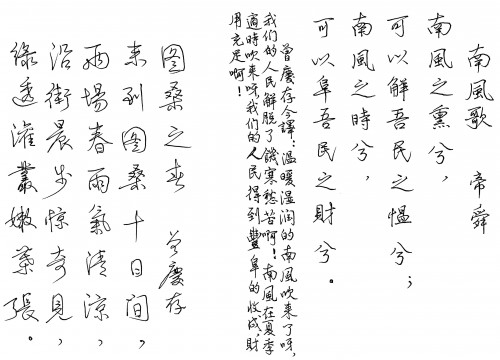
Don't Stop Now–Keep Meeting Year-Round!
Listening to interesting presentations from experts, encountering new ideas, chatting with old friends, and meeting new ones. This doesn’t have to stop in Atlanta: AMS local chapters provide the same networking opportunities and learning experiences all year long. Fortunately, the AMS Annual Meeting is a great time to find out more about them.
Local chapters have been a part of the American Meteorological Society’s framework almost from the beginning, with the first chapter formed in Boston in 1929. Whether you are a meteorology student or a professional, AMS chapters offer a superabundance of opportunities, from community outreach projects that further AMS goals, to engaging presentations from scientific leaders, to interactions with others in the profession. The likes of Louis Uccellini, director of the NWS; Rick Knabb, director of the National Hurricane Center; Ginger Zee, Good Morning America meteorologist; Bryan Norcross, Weather Channel meteorologist; and Bill Murtagh, program coordinator for the Space Weather Prediction Center have all captivated hundreds of members at local chapter meetings.
Local Chapters are active in many other ways. Members participate in
- student-run television weather shows
- collaborations with emergency managers to develop newspaper articles and storm safety tips
- tours of local news stations and NWS offices
- public school programs aimed at encouraging ethnically diverse students to pursue STEM degrees
- mixers for networking with meteorologists in all sectors of the field
- conferences such as the Annual Northeastern Storm Conference (which is in its 39th year)
This week at the Annual Meeting check out the Local Chapter poster display in Hall C3 and read about each chapter’s history and recent activities. You can also stop by the Local Chapter Booth at the AMS Resource Center in the Exhibit Hall (Booth 415) and take a look at a map showing the locations of each chapter. With 64 regular chapters and 74 student chapters throughout the US and Puerto Rico, there is bound to be a local chapter near you.
If you are unable to attend the Annual Meeting this year, worry not. Visit the Local Chapter Website at http://www.ametsoc.org/amschaps/ for more information, the Chapter Facebook page at http://www.facebook.com/amslcac, or contact the Local Chapter Affairs Committee at [email protected].
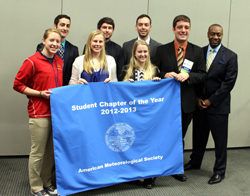
Congratulations to the Iowa State University chapter, the 2012-13 Student Chapter of the Year (above), and the North Florida chapter, the 2012-13 AMS Chapter of the Year (below).
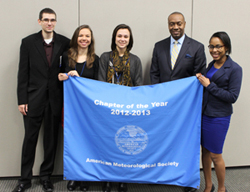
Buy This Book and Save the Planet
Saving the planet is a cooperative effort, says William Hooke of the AMS Policy Program. It will also take some humility, scientific savvy, a willingness to act on limited information, and an understanding of when to approximate and when to be precise. It also means dealing with a world of chaos–in short, it means thinking like a meteorologist. Hence, Hooke’s newly released AMS book, Living on the Real World: How Thinking and Acting Like Meteorologists Will Help Save the Planet. 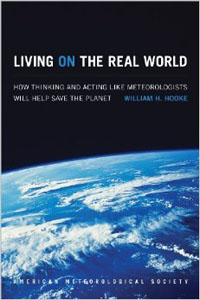
“It’s very easy in management to think that what you’re doing doesn’t matter very much,” he says. But, like the atmosphere, the slightest fluctuations have a significant impact and managers in science should consider Lorenz’s butterfly effect. “The littlest thing that I do has ripple effects that expand out and change the world forever,” he says. “That’s an important thing for every one of seven billion people to embrace. Otherwise, we feel we get lost, we’re insignificant in the scheme of things.”
Hooke sat down with BAMS Editor in Chief Jeff Rosenfeld to discuss the book and the importance of collaboration in meteorological research and even management; the whole interview can be found here. Stop by to meet Bill and get a copy of Living on the Real World at the book signing event at the AMS Resource Center in the Exhibit Hall during this afternoon’s poster session, 2:30 PM – 4 PM. Copies are limited, so it’s first-come, first-served, but the book will be released soon and available at the AMS Bookstore.
AMS Book Takes ASLI Awards by Storm
Wednesday afternoon, AMS Books will take a bow. Taken by Storm 1938: A Social and Meteorological History of the Great New England Hurricane, authored by Lourdes B. Avilés and published by the AMS, will receive an ASLI Choice Award in the historical category. 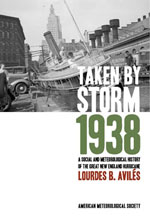 The book, which documents both the science of the storm and its social impacts, was recognized by ASLI for “its comprehensive account of this major storm, from its inception to aftermath.” (You can learn more about the book and see an interview with Avilés here.)
The book, which documents both the science of the storm and its social impacts, was recognized by ASLI for “its comprehensive account of this major storm, from its inception to aftermath.” (You can learn more about the book and see an interview with Avilés here.)
The winning title in the science and technology category is Mathematics and Climate, by Hans Kaper and Hans Engler, published by the Society for Industrial and Applied Mathematics. ASLI lauded the book for “its accessible explanations in key areas where climate and mathematics meet.” 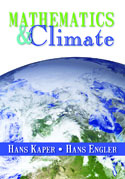 There was also an honorable mention in the historical category: Probing the Sky with Radio Waves: From Wireless Technology to the Development of Atmospheric Science, by Chen-Pang Yeang, published by the University of Chicago Press, selected for “its very thorough, technical history of radio waves and their importance to ionospheric science.”
There was also an honorable mention in the historical category: Probing the Sky with Radio Waves: From Wireless Technology to the Development of Atmospheric Science, by Chen-Pang Yeang, published by the University of Chicago Press, selected for “its very thorough, technical history of radio waves and their importance to ionospheric science.”
This is the ninth year that Atmospheric Science Librarians International has recognized the best books in in the fields of meteorology/climatology/atmospheric sciences. The award presentation will take place Wednesday at 4:45 at the ASLI booth (#732) in the Exhibit Hall, and before that, from 2:45 to 4:00, Avilés will be signing her book at the AMS Resource Center in the Exhibit Hall. Stop by, meet the author, and purchase a copy of her award-winning book!
The Polar Vortex Meets Rapid Refresh
In 1959 the AMS published a tome that became the touchstone document for a generation. The Glossary of Meteorology served its purpose well. So well that a 41-member editorial board and over 300 labored for five years to ensure the quality of the expanded, refreshed second edition of that volume…in 2000.
A lot happened in the meantime in the atmospheric sciences, largely because this community emphatically does not update itself solely on 41-year cycles.
Quite the contrary. There’s this thing called the Annual Meeting, for example. Refreshing our knowledge, contacts, perspectives, and priorities is what an AMS Annual Meeting is all about. If you peruse the program this week, you’ll find that practically every session has some abstract or title using the word “update.”
None of these presentations approaches updates with more earnestness than in the world of forecasting, where the pace of update has earned the phrase, “rapid refresh.” That would be RAP, in the parlance of the National Centers for Environmental Prediction: the 13-km resolution, hourly-updated mesoscale system so useful in convective forecasting, energy load prediction, and aviation products, among other things.
This week is a good opportunity to rapidly update your understanding of what’s going on with the newest edition of the RAP (version 2) and the nested 3-km rapid refreshing “High Resolution Rapid Refresh” model nested within it. HRRR is getting implemented at NCEP this year. Soon to follow are cloud microphysics enhancements and more. Eventually the rapid refresh pace will enter the world of ensembles, too. For more details get over to Room C203 today (Tuesday) at 2:45 PM to hear Stephen Weygandt et al. and then to the Georgia Ballroom 2 Wednesday at 11:15 AM to hear Stan Benjamin et al, and then again Room C203 for Patrick Hoffman et al.’s presentation on Thursday.
It seems only appropriate, then, to give credit to the Glossary for following the forecasters’ lead into the realm of rapid refresh. We no longer need wait 41 years for an update in defining the core terminology of scientific discourse. The Glossary has moved to the Web. Under the pioneering editorship of Mary Cairns, it takes about 50 days on average to peer review new definitions and terms. Then bingo, the word is officially published.
This week, in fact, while RAP is working on its updates, the Glossary came out with one of its own. The word of the month—or at least in January—was the “polar vortex.” Here’s a peak at what “polar vortex” meant in 1959:
polar vortex–(Also called polar cyclone, polar low, circumpolar whirl.) The large-scale cyclonic circulation in the middle and upper troposphere centered generally in the polar regions. Specifically, the vortex has two centers in the mean, one near Baffin Island and another over northeast Siberia. The associated cyclonic wind system comprises the westerlies of middle latitudes.
As it turns out, observations were already showing that the polar vortex was not merely a stratospheric phenomenon. This was one of the major changes incorporated in the 2000 edition. But during the endless media mangling of the polar vortex during the recent cold snaps and snows, experts discussing the terminology found some problems with the way the second edition had formulated the definition. So…a proposal for a change was submitted to chief editor Cairns. Within a few weeks, the proposal was peer reviewed and resulted in a new definition posted 30 January 2014.
Cairns tells us the new definition removes an inaccuracy and was updated to eliminate ambiguity and define seasonal characteristics of the vortex evolution. There is also now new language specifically addressing a subdefinition for the “polar stratospheric vortex.” It reads:
A planetary-scale mid- to high-latitude circumpolar cyclonic circulation, extending from the middle troposphere to the stratosphere. The Northern Hemisphere vortex often features two centers—one near Baffin Island and the other over northeast Siberia—with analogous circumpolar asymmetry atypical in the Southern Hemisphere. The westerly airflow is largely a manifestation of the thermal wind above the polar frontal zone of middle and subpolar latitudes. The vortex is strongest during the winter in the upper troposphere and stratosphere when the pole-to-equator temperature gradient is strongest. The stratosphere component of the circulation may be referred to separately as the “polar stratospheric vortex.” In summer, the strongest westerly circulation is largely confined to the troposphere, and the polar stratospheric vortex reverses in the upper stratosphere because of solar heating during the polar day.
But enough with the polar vortex, right? Back to our own ongoing rapid refresh here in Atlanta.
AMS Presidential Town Hall Meeting to Stress Adaptation, Resilience to Climate Change
In weather forecasting, the past is often a harbinger of the future. In a rapidly urbanizing world facing climate change, however, the future looks less and less like the past. With a theme of Building, Sustaining, and Improving our Weather and Climate Hazard Resilience, we’re facing this problem head on at the AMS Annual Meeting, nowhere more so than in tonight’s Presidential Town Hall Meeting (7:00–8:30 p.m., Room C111 of the Georgia World Congress Center).
The speakers include FEMA Administrator Craig Fugate and an IPCC coordinating lead author, Donald Wuebbles—two key figures in communicating climate change hazards and adaptation. Helping all to visualize extremes in the weather will be NCAR’s Mel Shapiro—a master at telling a tale through stunning imagery. This time his tale is Superstorm Sandy, which crashed ashore in the Northeast in fall 2012 with deadly fury. Sandy exposed just how vulnerable our nation is to natural disasters. Storm surge flooding didn’t just wreck the beaches, our playgrounds at the shore. Seawater rushed inland, flooding airports and mass transportation routes and partially disconnecting the biggest city in America—and financial heart of the nation—from its neighbors. The price tag was enormous.
You’ll hear a lot at the Town Hall about how weather- and climate-driven disasters in America are costing us more and more. Multibillion-dollar weather disasters, once consisting solely of major hurricanes and extended drought, are becoming common—even from small-scale thunderstorms. With a climate that’s heating up–resulting in an increase in extreme weather, as Wuebbles will discuss–so too will we see an increase is such megadisasters.
Wuebbles’ playbook on Monday will be the fifth assessment report (AR5) of climate change by the Intergovernmental Panel on Climate Change (IPCC). Wuebbles was coordinating lead author of the Working Group 1 section, which was released in full form last week. He says he plans to overview its findings with “an emphasis on our state of understanding of severe weather events under a changing climate.” The presentation will include a preview of the U.S. National Climate Assessment to be released in April.
Wuebbles, who is an atmospheric science professor at the University of Illinois, will also report from a series of NOAA workshops evaluating attribution science (in BAMS here, here, and here), which currently supports making useful projections on some but not all types of severe-weather events. Projections of heat waves and cold spells as well as heavy precipitation events are now possible, and “meaningful trends in floods and droughts” are also discernible by region in the United States. Confidence in an increase in hurricane intensity as the climate warms is also growing. But forecasts of how climate change will affect severe thunderstorms and tornadoes, which in recent years have broken into the billion-dollar disaster range, remain out of reach for now, Wuebbles says, but he adds, “By the next assessment we may be able to make stronger statements.”
Even without the financial burden, today’s weather disasters are becoming debilitating. Look no further than last week’s shutdown of Atlanta due to a well-forecast snowfall. It shouldn’t have happened—particularly since the city went through the same thing just three years ago (January 2011), only with a slightly heavier snowfall. No one thought it could happen again, but it did.
Our ability to successfully communicate is challenged most when disaster strikes. That’s where Fugate comes in. As the top emergency manager in the nation, his job is to organize meaningful and rapid response, which relies on successful communication.
The key is to organize lines of communication beforehand, so when the weather becomes extreme, the avenues of information will remain open. But there are other forms of disaster response. Fugate sees resilience to disaster through increasing adaptation as the way forward in a changing climate. By reducing the risk, he believes we can manage to recover more quickly from extreme weather events. Most importantly, in his view, is to turn victims of disaster into what he prefers them to be called: survivors. He encourages neighbors and communities to get better at coming together when disaster occurs and to help each other overcome the odds and survive.
As AMS Associate Executive Director Bill Hooke explains in Sunday’s Living on the Real World column, there are many levels of disaster response, and all of them “need to be mastered.” When disaster strikes a community, its residents probably will look to the top command-and-control such as FEMA to make things right. But at the other end of disaster response is personal responsibility. Each of us has the task before us to take action to improve our situation. We can wait for disaster to strike, but better would be to plan now how to adapt and make ourselves resilient to weather and climate hazards so they won’t turn into catastrophes.
Reassessing the Enhanced Fujita Tornado Scale
It’s been more than 40 years since Ted Fujita introduced his renowned Tornado Damage Scale – the Fujita Scale. And nearly a decade has passed since top tornado scientists first collaborated with structural engineers to create the Enhanced Fujita (EF) Scale for rating tornado winds more accurately based on advances in our understanding of the variety of damage they inflict. Now, an effort is underway to tweak the EF Scale further – and the National Weather Service is looking for input from AMS meeting attendees this week.
The effort stems from the observations and analysis of recent violent tornado events: the massive tornado outbreak across the South in April 2011; the violent (EF5) Joplin, Missouri tornado of May 2011; and the Newcastle-Moore, Oklahoma EF5 tornado of May 2013. Survey teams were able to use more than two dozen “damage indicators,” such as wood-frame homes, strip malls, and schools—each further categorized by multiple “degrees of damage”—to gauge tornadic winds. But questions and even discrepancies arose among the survey teams as they scoured the wreckage of entire neighborhoods.
Oral and poster presentations throughout this week at the AMS Annual Meeting in Atlanta share information about the damage surveys, findings from reports such as the National Institute of Standards and Technology (NIST) technical investigation of the Joplin tornado and FEMA’s Mitigation Assessment Team Report on the Spring 2011 tornadoes, as well as thoughts for improving the EF-scale:
- The Joplin Tornado: Lessons Learned from the NIST Investigation (Tuesday, 9:15 a.m., Georgia Ballroom 2)
- Damage Survey and Analysis of the 20 May 2013 Newcastle-Moore, OK, EF-5 Tornado (Poster 828, Wednesday, 2:30-4 p.m., Hall C3)
- Aerial Damage Survey Analysis of the 20 May 2013 Moore Tornado (Poster 829, Wednesday, 2:30-4 p.m., Hall C3)
- Side-by-side tree and house damage in the May 2013 Moore, OK EF-5 tornado: Lessons for the Enhanced Fujita scale (Poster 831, Wednesday, 2:30-4 p.m., Hall C3)
- A related poster presentation looks at assigning EF-scale ratings to tree damage in severely damaged forests using only aerial photos.
- Photogrammetric analysis, from the ground and the air, was also used to survey the huge El Reno, Oklahoma of May 31, 2013,
- Terminal Doppler Weather Radar (TDWR) in Oklahoma City captured rare up-close velocity data of the Newcastle-Moore tornado that can be compared with survey estimates of tornado damage and intensity rankings.
All of these represent on-going thinking about the EF Scale and how to refine it.
If you’d like to get involved, NWS is hosting an open discussion of the EF Scale to acquire feedback on its strengths and deficiencies. Space is limited so sign up today.